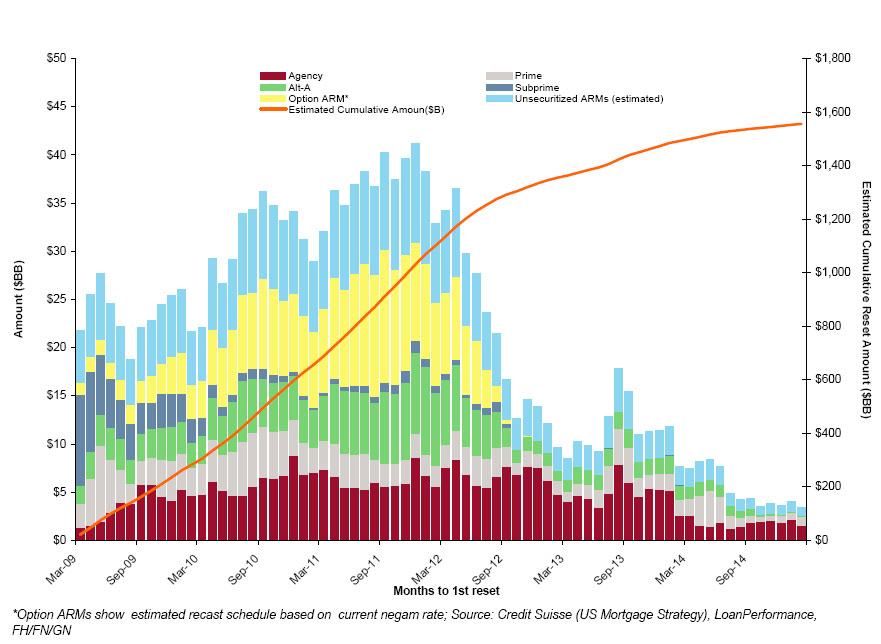A particularly toxic form of adjustable rate mortgage is going to hit the headlines in the spring and summer of 2010 with defaults, foreclosures and workout discussions extending into 2012. “Option ARMs” also known as “Pick-a-pay” allow the borrower to choose how much to pay each month and reports indicate 94% of all borrowers paid the minimum. What’s the catch? The difference between the minimum and the actual loan rate gets added to the loan balance creating “negative amortization”.
These loans were originated in the 2004-2007 bubble period with a majority sold during the peak year, 2006. They were popular in high cost areas, typically more exurban and inland places where houses were slightly more affordable. A Moody’s report mentions that 54% of these loans were made in California and another 13% in Florida. The next largest origination states were Arizona and Nevada. About 28% of all home loans originated in the 2004-2008 period in Vallejo-Fairfield (Solano County) California were option ARMs. One quarter of the home loans originated in Santa-Rosa-Petaluma in Sonoma County were Option ARMs. These figures are according to the San Francisco Chronicle.
The following chart shows the top-10 MSA’s by size of outstanding option ARM balance, including negative amortization, thanks to Alla Sirotic of Fitch Ratings. Note that these are as of August, 2009 so the balances may be different today. Also, these represent Non-agency RMBS (residential mortgage backed securities).
The payment option mortgage lured buyers into thinking a big, new house could be affordable. The pitch? The borrower thought he/she could re-finance into a more sensible structure or in the worst case, sell the house and pocket some additional equity. Many of these loans were also used by speculators who hoped to make a profit on the sale and by holders whose files were poorly or fraudulently documented. Articles citing homeowners who were told the loans had no risk abound. The housing bust is driving down values and some of the 2006 vintage loans now have a loan-to-value (LTV) of 163%, making the refinance or resale prospect out of the question.
Many of the loan structures had a period of five years before the loans re-cast to fully amortizing and fully loaded interest – hence the toxic brew hitting in 2010-2012. Around 78% of the option ARMs have yet to recast, and of those loans, 93% have negative amortization, according to a recent Standard and Poor’s teleconference. The structures also typically carry an amortization trigger when the loan exceeds 110%-125% of the original balance, which could happen before the five year period. The recast payments could be significantly higher than the monthly amount the homeowner deemed affordable at origination.
A popular chart that has been circulating among the housing bubble blogs comes from Credit Suisse and shows the timeline for adjustable rate mortgage resets and option ARM recasts. While the bulk of sub-prime adjustable interest rate mortgages have been re-structured, or are making their way through the foreclosure process, the chart illustrate how option ARMs recasts have yet to hit the fan. (This version from the “Mortgage Insider, Matthew Padilla of the Orange County Register, updated through April 2009.)
The solution? Moody’s concludes that loan adjustment is really the only feasible solution, short of major additional dislocation for homeowners and additional heavy mark-to-market write-downs for the institutions holding this paper. Wells Fargo is reportedly doing just this on mortgages it owns on the books (accounting for some of the discrepancy in the numbers). On the political front, the prospect of loan modification is highly controversial. Some elected officials do not want to look like they favor one group of troubled homeowners over another. Hmmm.
Finally, the size of this coming problem is also controversial. Credit Suisse had to make some assumptions regarding recast dates. Since payment amounts are, well, optional, the level of negative amortization must be estimated and the time when these loans hit the trigger ahead of the five-year period is also estimated. Some loans were 40-year, rather than 30-year, complicating the calculations further. Moody’s and Fitch’s numbers show about $200 billion will be recast in the 2010-2012 period. The Wall Street Journal cited $750 billion originated between 2004 and 2007 (according to Inside Mortgage Finance). Some of the discrepancy is between publicly held RMB (residential mortgage-backed) securitizations, loans held on bank balance sheets and agency securities. Sirotic points out that Non-Agency RMBS volume is approximately 17% of the overall outstanding US mortgage market and securitized Option ARMs represent about 13% of the Non-Agency RMBS. There are definitely more Option Arms loans that are held in bank portfolios, she commented. So the rest are in federal agency securities, FNMA, FHLMC and GNMA, now a federal balance sheet problem.
A Barclay’s report mentions that many of these loans are already in default ahead of the recast and so should be removed from the numbers. (So is this good news or bad news?) Housing Wire further reinforces this point: “The prospect of option ARMs swollen with negative amortization coming to recast and defaulting on a massive scale inspires bond investor fear — and hysterical headlines — but the real fallout might be dimmed by the share of loans that have already foreclosed and no longer remain in the pool.” Stephen Berg, MD of Lender Processing Services told Housing Wire that they only had about 800,000 active option ARMS. Whether you think 800,000 loans and $750 billion are small or large numbers, the option ARM will punch more holes in household, government and institutional balance sheets in the coming months.
